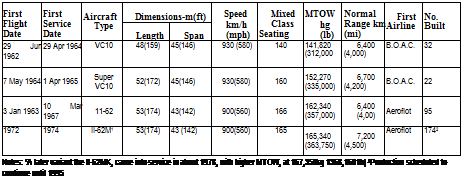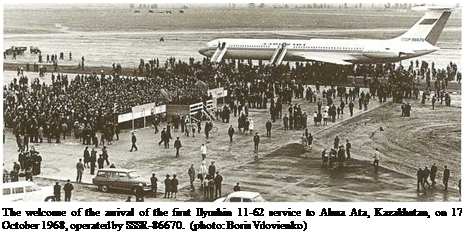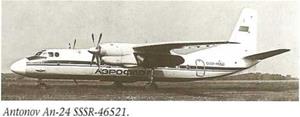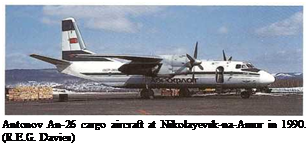Ilyushin ІІ-62ІУ
 165 SEATS ■ 900km/h (560mph)
165 SEATS ■ 900km/h (560mph)
Soloviev D-30KU (4 x 11,000kg st, 24,2501b st) ■ MTOW 165,340kg (363,7501b) ■ Normal Range 7,200km (4,500mi)



 |
IL-62 REGISTRATION
BLOCKS
Mixed Fortunes
The early 1970s were good for the 11-62 . On 4 November 1972, it brought the Soviet airline to a new Latin American ally, Chile, where a Marxist government under Salvador Allende assumed power. The service was routed via Rabat, Havana, and Lima; but was curtailed to the Peruvian capital when the Allende government was overthrown after only two years in office.
Of great political importance was a second route to the United States, inaugurated on 5 April 1974, with direct Ilyushin 11-62 service from capital to capital, Moscow to Washington. Still stopping at Shannon and Gander, a moderate improvement was to omit either one or the other of these technical stops with the introduction of the Ilyushin II-62M (I1-62M-200), a modified variant of the original design with new engines and increased fuel capacity. For in spite of its record of carrying Aeroflot’s flag throughout the world’s intercontinental route network, there had been many technical problems. On 13 October 1972, on a charter flight, an 11-62 crashed at Sheremetyevo Airport in Moscow, killing 176 people. At the time, this was the greatest airline disaster on record. But the 11-62 survived all vicissitudes and remains today as Aeroflot’s front-line airliner for all long-distance routes beyond the non-stop capability of the wide-bodied Ilyushin 11-86 (see page 89).
 |
They Also Served
In the world of aviation, the headlines are always devoted to spectacular events; or to the biggest and the fastest. The smaller airliners, designed to match the traffic demand on hundreds of routes to regions of low population density, have passed almost unnoticed.
When the Antonov An-24 entered service on 9 October 1962, it attracted little attention. This was the year when the Tupolev Tu-104 began service to southeast Asia, the Ilyushin 11-18 to West Africa, and the first Tupolev Tu-114 flights began from Moscow to Havana. The little 40-seater twin was a poor relation, compared with these.
Yet today, thirty years later, the Antonov An-24 is still to be seen everywhere, throughout the vast expanses of European Russia, Ukraine, and Siberia, dozens of them lined

 up at every major traffic hub, and serving countless regional route networks with regularity and reliability. While the larger and faster jets grabbed the headlines, the An-24 quietly got on with the job, serving the Soviet people in hundreds of small communities. When, by 1967, Aeroflot was able to claim to be the largest airline in the world, this was as much because of the efforts of the diminutive An-24 as it was of the giant Tu-114. And while the Tu-104 and the Tu-114 are now retired — honorably, it should be noted — and the Tu – 134 is approaching that status, the Antonov An-24 flies on. Like its partner, the 12-seat An-2, which came out of the same design bureau at Kiev, the now 48-seater will probably still be serving Aeroflot into the next century. It has been exported to several countries in eastern Europe, Africa, and the Middle East.
up at every major traffic hub, and serving countless regional route networks with regularity and reliability. While the larger and faster jets grabbed the headlines, the An-24 quietly got on with the job, serving the Soviet people in hundreds of small communities. When, by 1967, Aeroflot was able to claim to be the largest airline in the world, this was as much because of the efforts of the diminutive An-24 as it was of the giant Tu-114. And while the Tu-104 and the Tu-114 are now retired — honorably, it should be noted — and the Tu – 134 is approaching that status, the Antonov An-24 flies on. Like its partner, the 12-seat An-2, which came out of the same design bureau at Kiev, the now 48-seater will probably still be serving Aeroflot into the next century. It has been exported to several countries in eastern Europe, Africa, and the Middle East.
![]()
 This map does not show the hundreds of bush services that radiate from all main citi<
This map does not show the hundreds of bush services that radiate from all main citi<
o Nordvik
|
T |
slaA^ |
 IN THE 1960S
IN THE 1960S

![]() (before Tupolev Tu-114/llyushin II-62 services)
(before Tupolev Tu-114/llyushin II-62 services)










